Today is April 30th, which means it is exactly halfway to Halloween 2019, so in the spirit of a day that’s not really Halloween, I provide you a screen cap from a Halloween movie, that’s not really a Halloween movie.
 That’s right, 1982’s Halloween III: Season of the Witch is one of the most bizarre sequels in horror movie history in the sense that the movie has ABSOLUTELY NOTHING to do with any movie in the Halloween series that came before or after it. The story line doesn’t even make an attempt to loosely include Michael Myers or anything from the first two movies in a some sort of “Michael Myers in Space” or “Michael Myers vs Sharknado” tie in. Imagine if there was a Nightmare on Elm Street sequel all about teenage vampires, with no Freddy Krueger, or a Hellraiser film featuring killer clowns from outer space, but no Pinhead (OKay, I’d like to see that). It’s just weird!
That’s right, 1982’s Halloween III: Season of the Witch is one of the most bizarre sequels in horror movie history in the sense that the movie has ABSOLUTELY NOTHING to do with any movie in the Halloween series that came before or after it. The story line doesn’t even make an attempt to loosely include Michael Myers or anything from the first two movies in a some sort of “Michael Myers in Space” or “Michael Myers vs Sharknado” tie in. Imagine if there was a Nightmare on Elm Street sequel all about teenage vampires, with no Freddy Krueger, or a Hellraiser film featuring killer clowns from outer space, but no Pinhead (OKay, I’d like to see that). It’s just weird!

Nope, Season of the Witch follows a story of a crazy toy company called Silver Shamrock who comes up with a devious plan to produce a series of Halloween masks that when worn on Halloween will murder anyone wearing it, literally melting their heads. The trigger for this mask-induced murderous rampage is through an electric signal emitted by any TV playing a commercial for the Silver Shamrock company. It’s theme song is strangely catchy and will have you signing it for days after watching the movie, so I guess that’s what does it.
It’s an absolutely ridiculous premise, that unbelievably, kinda, sorta works. The movie itself amazingly isn’t that bad and it was produced by John Carpenter, who remains one of the greatest horror masters of all time. It’s at least on par with countless other cheesy 1980s horror flicks, but the question that is still being pondered today, 36 years after it’s release is, WHY DID THEY CALL IT HALLOWEEN III?
Nevertheless, the movie is out there, and if the renewal of spring, birds tweeting, and flowers blooming makes you long for some mid-fall horror movies, then it’s worth checking out. Also worth checking out, is the 6th post in my “Cameras of the Dead” series where I take a look at 3 cameras that may or may not have worn a Silver Shamrock mask at some point in their past, because their days of making photographs are long gone.
Pax 35 (1952)
This is a Pax 35, a 35mm rangefinder camera made by Yamato Kōki Kōgyō K.K. between the years of 1952 to 1955. The history of Yamato is confusing as it was the third Japanese company with this same name, and it’s roots may or may not be traced to a Japanese distributor called Hagimoto Danji. The Pax 35 was the first in a series of compact fixed lens cameras that bear an intentional resemblance to the Barnack Leica. Apart from this resemblance, the Pax does not compare in any way shape or form to the Leica. It was an inexpensive and very basic camera with limited shutter speeds, a basic viewfinder and questionable build quality. Pax 35 cameras have not fared well over the years and very few still work today.
Film Type: 135 (35mm)
Lens: 45mm f/3.5 Luminor Anastigmat coated 3-elements
Focus: 3 feet to Infinity
Viewfinder: Separate Viewfinder and Coupled Rangefinder Windows
Shutter: VKK Leaf
Speeds: B, 1/25 – 1/150 seconds
Exposure Meter: None
Battery: None
Flash Mount: Coldshoe and FP and X Flash Sync
Weight: 444 grams
Manual: http://www.cameramanuals.org/pdf_files/pax-35.pdf
My Thoughts

I mentioned it in the intro above, but it bears repeating. At a quick glance, the Pax 35 may resemble a Barnack Leica, but other than it’s use of 35mm film, the two cameras have almost nothing in common. This is a crudely built, basic camera, with a cheap leaf shutter, a fixed triplet lens, and a much smaller body. The image to the right shows the Pax 35 side by side with a Zorki 1, which has identical dimensions as the Barnack Leica it was based off. Not only is the Pax smaller in every physical dimension, it’s quite a bit lighter. At 444 grams, it is lighter than the Zorki 1 at 573, and a (not pictured) Canon IVSb at 660 grams.
Further confirming it’s economy build quality, nearly every Pax camera found today is in an inoperable state. While many classic cameras today are found with operational issues, Pax cameras seem to be in unusually worse condition.
Master camera tinkerer, Rick Oleson took apart a Pax M2 and shared his thoughts on his Flickr page where it took him soaking the camera for multiple days in xylene to free it up. I contacted Rick to get more insight on the process and here were his comments:
I’m not certain how long it actually took in the Xylene before it freed up. I had tried naphtha, acetone, alcohol, basically all of the usual milder stuff and some that I was reluctant to try. Finally I bought a can of Xylene – I’m not certain why I chose that, except that Xylene and Toluene seem to be the main ingredients of the strongest “goof-off” type solvents. I filled a glass jar with the stuff, removed the lenses from the shutter and the shutter/focus mount assembly from the camera, and dropped it into the jar and closed it up. Seems like it was 4 or 5 days before I checked on it and found it to have come unglued. I had spent longer than that with the other solvents with no effect at all. It might have actually freed up in a day or two in the Xylene but given my earlier experience I didn’t bother to check on it for a longer time.
The example being reviewed here was in much the same condition as Rick’s M2, in that the helix was completely seized. No amount of muscle would move it, and I fear that if I were to keep trying to force it, I would permanently break it.
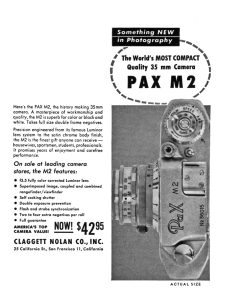
Even without the ability to change the focus, handing the camera, I could feel the cheapness in it’s design. When Japanese companies like Nippon Kogaku (Nikon) and Canon made an effort to break into western markets, many photographers were skeptical of Japanese made cameras because they had a generally poor reputation for quality, and it was cameras like the Pax that were partially responsible for that.
Pax cameras were inexpensive entry level cameras, and that’s not necessarily a bad thing. I’ve reviewed many simple box cameras, or entry level plastic models favorably, so why the harsh criticism of the Pax?
I think their attempts to make the camera look like a Leica was a poor choice. It’s hard to take a camera seriously that so closely resembles something so well made. Later cameras in the Pax lineup would wisely change their cosmetics, but whenever I see this little thing, it’s really hard to disconnect my thoughts from what the camera was likely trying to copy.
I could not find any advertisements for the original model being reviewed here, but an ad for the later Pax M2 from May 1957 reveals it’s price to be $42.95, that when adjusted for inflation is about $390 today. Certainly not a cheap camera, but a far cry from the high end German cameras that cost 3-4 times as much.
Setting aside any Leica-like looks that it has, I’ll admit that when it was first released, the camera likely had some charm. The ergonomics of the camera aren’t terrible, it has a coincident image rangefinder, a top plate shutter release, and flash synchronization. In the right hands, the camera was likely capable of good shots.
At a quick glance, the top plate is like a condensed Leica, save for the shutter speed dial, which doesn’t need to be there, since it’s set around the perimeter of the lens. The accessory shoe was strangely missing from this particular example, revealing what looks like a rangefinder adjustment screw. On the bottom of the camera are two feet, one of which contains the tripod mount, and a lock ring in the center for removing the back and bottom of the camera.
With the back of the camera off, we can see into the film compartment, which reveals several other clues to the camera’s budget origins. Some kind of metal rod which looks to be part of the shutter release coupling is clearly visible next to the lens. Film loads from left to right, onto a fixed take up spool. Functionally, it’s not too bad as I’ve seen poorer designed film compartments.
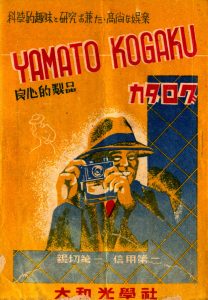
Like nearly all leaf shutter cameras, all of the camera’s critical controls are accessed around the front of the lens. Shutter speed is selected with the ring on the outer rim of the lens, and aperture with the ring behind it. Protruding out of the top of the shutter near the 1 o’clock position is the shutter cocking lever, which strangely has the shortest throw of any lever of it’s kind I’ve seen on any camera. Focus is controlled by the large arm at the very bottom of the lens. I don’t know if this was designed intentionally, but when placed exactly at the 6 o’clock position, the focus arm acts as sort of a kickstand allowing you to rest the camera on a flat surface without it falling forward.
I have a confession. I’ve long held a pretty negative opinion of Pax cameras, and perhaps the later models are deserving of this derision, but after handling this little Pax 35, it started to grow on me. I wrote the early part of this review shortly after acquiring this camera, and now as I type this, it’s been several weeks later, and my original comments about it’s cheapness and poor build quality now seem a little unfair. This camera really is not THAT bad.
Gasp! Was I actually starting the like this little thing? It was definitely broken, and completely inoperable, so there’s no way I could use it, so it’s inclusion here in a Camera of the Dead post was inevitable. But at the very least, I now feel sorta bad for the little camera. I wish there was something I could do about it…hmm, maybe I should call up my buddy Rick…
Kiev 5 (1972)
This is a Kiev 5, a 35mm rangefinder camera made at the Arsenal plant in Kiev, Ukraine, in the former Soviet Union between the years 1967 to 1973. The Kiev 5 was a heavily updated version of the Kiev III and 4, which were near identical copies to the Zeiss-Ikon Contax rangefinder. The Kiev 5 improved upon the earlier models with a much larger viewfinder with projected frame lines and a shorter base rangefinder. It has a lever wind film advance, a modified Contax lens mount, and an integrated selenium exposure meter. Although a much improved model, the upgrades greatly increased the cost of the camera and it did not sell well, being discontinued in 1973.
Film Type: 135 (35mm)
Lens: 50mm f/2 Jupiter-8 NB Coated 4-elements
Lens Mount: Kiev 5 Bayonet (Contax Outer only)
Focus: 17 Inches to Infinity
Viewfinder: Coupled Coincident Image Rangefinder.
Shutter: Vertical Metal “garage door” Focal Plane
Speeds: B, 1 – 1/1250 seconds
Exposure Meter: Coupled Selenium Cell w/ Top Plate Readout
Battery: None
Flash Mount: PC post with M and X sync
Weight: 925 grams (w/ lens), 735 grams (body only)
Manual: None
My Thoughts
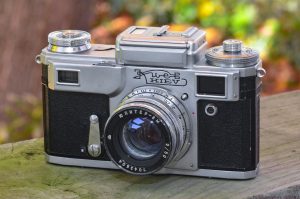
I wrote about the Kiev 4 way back in May 2015 when I first started this site. It was one of my first 10 reviews, and the first Soviet camera I ever shot film with. I still have that camera, but sadly I’ve neglected it for the past 4 years, letting it sit on my shelf waiting for a chance to shoot it again.
One of my biggest complaints with the camera is the small viewfinder with the eyeglass scratching metal ring around it. This is a camera that people who wear prescription glasses need to be really cautious of because the sharp metal is very rough on lens coatings. It’s a problem discussed on other sites where users have chosen to use adhesive backed pieces of felt and vinyl to cover up the sharp edges around the eye piece. The camera covering site, aki-asahi.com from Japan even sells pre-cut eyepiece patches for these cameras.
I know, excuses, excuses. There are many other cameras with tiny viewfinders that you need to be mindful of while using, but I’ll just say that I’ve always wanted to revisit this camera.
Then one day while browsing through Vladislav Kern’s collection over at ussrphoto.com, he handed me a Kiev 5 which I knew to be a short lived replacement to the Kiev 4 with several enhancements.
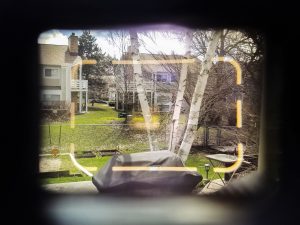
The significantly larger viewfinder is the most obvious change. The Arsenal plant where this camera was made, came up with a completely new coincident image rangefinder that was not only larger, but had a shorter base than the original Contax inspired one. The shorter rangefinder base meant the window for the coincident image could be closer to the center of the camera and not be so easily blocked by the photographer’s right hand. Early prototypes of the Kiev 5 had automatic parallax correction, but this was removed near the beginning of regular production. Additional enhancements were a film advance lever instead of a knob, and a change to the Contax lens mount, removing the internal bayonet and internal helicoid.
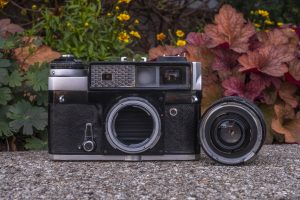
The original Contax mount used on all Contax rangefinders, the Kiev 4, and the Nikon S-series, is a dual bayonet mount. An internal bayonet is used for most 50mm lenses and has it’s own helicoid for focus. For every other lens, there was an external bayonet that required the lens to have it’s own helicoid. The advantage of the original design was that 50mm lenses were very compact and focused using the camera’s helicoid. Of course, this complicated the mount, so in an effort to make it cheaper and easier to produce, Arsenal completely removed this internal mount.
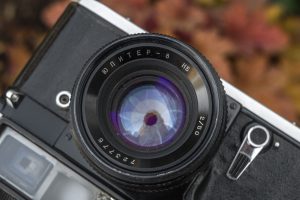
An obvious side effect of this is that any previous Kiev (or Contax) mount lenses that used the internal mount, were not compatible with the Kiev 5. Arsenal had to come up with a new standard 50mm lens that would mount using the external bayonet. Originally, a modified Jupiter 8, called the Jupiter 8 NB was offered, but later, a faster f/1.8 Helios-94 replaced it.
The upgraded Kiev 5 was first released in 1968 (some prototypes from 1967 exist) and was sold at a premium to the Kiev 4. There doesn’t seem to be any conclusive estimates of how many Kiev 5s were ever sold, but all references to production consider it to be quite rare. Sovietcams.com suggests a total production of anywhere between 8000 and 50,000 units. My guess is the number is probably closer to the lower number.
Reasons for the Kiev 5’s failure was likely due to it’s expense. Not many people in the Soviet Union during this time had an excess of money to spend on top of the line rangefinders like the Kiev 5. Millions of inexpensive Smenas, Zorkis, and FEDs were available for much cheaper prices that catered to the average person looking for a camera. Possibly further adding to the slow sales was that the Kiev 4 series was still available concurrently with the Kiev 5, meaning that if someone wanted a similar camera, they could still have the 4 at what I can only assume was a substantial cost savings.
Setting aside everything on the top plate, the rest of the camera works just like the Kiev 4. The shutter mechanism is exactly the same, and like on the Kiev 4, you MUST cock the shutter first before changing shutter speeds. The film back comes completely off the camera using the two locks on the bottom plate and loading film is the same as previous Kievs and the Contax rangefinders that came before it.
The removal of the internal bayonet with the focusing helix from the previous model also required removal of the saw tooth focusing wheel on the top plate of the Kiev 4. This isn’t necessarily a bad thing as I’ve always found this wheel on cameras that had it (including Nikon rangefinders) to be uncomfortable to use. I also have to imagine that this simplified the camera, eliminating more pieces to fail.
The Kiev 4 is an imperfect, but nice camera that I’ve always enjoyed using, and while finding one in good working condition today is a bit of a challenge, your odds are no worse than finding a working Contax rangefinder which they were based off. The Kiev 5 improves on the Kiev 4 in almost every way that it needed to be. The viewfinder is MUCH larger and easier to use, the meter readout is located within the top plate and no longer looks like an afterthought, there’s a film advance lever, the shutter speed selector is larger and easier to use, and the side mounted rewind knob has a fold out lever (this would eventually be added to the Kiev 4M starting in 1976).
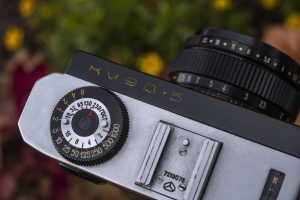
Yet, despite all of these improvements, the camera’s biggest weakness is still it’s shutter. An unnecessarily complicated design that dates back to the 1930s that Zeiss themselves struggled to make work correctly. It was a design that Nippon Kogaku wisely chose not to copy when they built their first rangefinders in the late 1940s. In addition to the various complexities, the curtains themselves were held together with strips of cloth that simply weren’t designed to last decades, and few are found working today…including this one.
When I first picked up this Kiev 5, the shutter was working. I dry fired it a couple of times before taking it home, and it continued to work after loading in a roll of film to test it out, but after a single exposure, the shutter snapped and upon reopening the back of the camera (I rewound the film back into the cassette first), I could see the first curtain would no longer move.
Thankfully, Vladislav was understanding in that these things almost never work and a shutter issue like this was inevitable. Although I had to return the camera to it’s owner without ever shooting any images in it, I felt it was worthy of some kind of mention, if only, as a камера смерти.
Canon T90 (1986)
This is a Canon T90, a professional quality 35mm SLR camera made by Canon Inc. between the years 1986 to 1998. At the time of it’s release, it was Canon’s top of the line SLR in their T-series and the most advanced manual focus FD-mount Canon camera ever made. It was a well featured camera loaded with state of the art technology and was very popular with professional photographers. Built to a very high level of quality, it was nicknamed as “the tank” by Japanese photojournalists because of it’s heft and durability. Although an extremely well made camera, it had one technological flaw which didn’t show up until about 20 or so years after it was made, which causes the shutter to fail in nearly all examples of the camera, producing an EEE error message in the LCD.
Film Type: 135 (35mm)
Lens: 50mm f/1.4 Canon Lens coated 6-elements
Lens Mount: Canon FL/FD Breech Lock Bayonet
Focus: Variable
Viewfinder: Fixed Pentaprism Reflex with interchangeable viewing screens, and dual LED/LCD readout
Shutter: Vertically Traveling Electronic Shutter
Speeds: B, 30 – 1/4000 seconds, Stepless, Manually selectable in 1/2 stops
Exposure Meter: Silicon Photo Cell w/ 3 metering patterns
Battery: (4) AA Alkaline/NiCD/NiMH 1.5v batteries
Flash: Hotshoe with 1/250 Flash Sync
Weight: 1190 grams (w/ lens), 887 grams (body only)
Manual: http://www.cameramanuals.org/canon_pdf/canon_t90.pdf
Sales Brochure: https://www.pacificrimcamera.com/rl/00285/00285.pdf
My Thoughts

In the vintage camera world, there are cameras that have a reputation for extreme reliability. Models that assuming they were not horribly abused throughout their lives almost always still work. Kodak Brownies, Argus C3s, Nikon Fs, and Minolta SRTs are a couple such examples.
On the other end of the spectrum, there are those that almost always have problems. Whether it’s due to shoddy craftsmanship, an overly complicated design, or the planned obsolescence of electronics, these examples are almost never found in good working order.
This is about a camera from that latter group, the Canon T90.
The biggest shame about this, is that when in working condition, the Canon T90 is an absolute beast of a camera. It was a state of the art professional model that with the exception of auto focus, could do everything a photographer in the 1980s could ever imagine.
Advertised as a “dream camera”, the T90 featured 3 different electronic motors, one of which offered 4.5 fps continuous shooting, a top 1/4000 second shutter speed, a high-speed 1/250 second flash synchronization, three metering modes with multi-point spot metering, an advanced viewfinder with 7-segment LED display, and a bevy of other options. The camera was big, it was heavy, and it was expensive. Selling for $599 body only, which when adjusted for inflation is about $1400 today, the Canon T90 was the most expensive manual focus camera Canon ever offered until that point.
But therein lied it’s biggest flaw. Canon wanted to include so much technology in the camera as they possibly could, but unfortunately, they did it at a time when compact electronics were still quite primitive. Canon used a lot of cutting edge stuff in the T90 that has not aged well.

 Like any electronic camera, the camera is sensitive to shock, moisture, and extreme temperatures. But beyond that, it had one problem that nearly every example seems to suffer from today, which is the dreaded “EEE” message on the camera’s top LCD. While this message could mean one of a variety of faults with the camera, it usually has to do with some kind of solenoid beneath the reflex mirror that controls some part of the shutter (if I’m sounding exceptionally vague here, it’s because I still don’t completely understand the problem).
Like any electronic camera, the camera is sensitive to shock, moisture, and extreme temperatures. But beyond that, it had one problem that nearly every example seems to suffer from today, which is the dreaded “EEE” message on the camera’s top LCD. While this message could mean one of a variety of faults with the camera, it usually has to do with some kind of solenoid beneath the reflex mirror that controls some part of the shutter (if I’m sounding exceptionally vague here, it’s because I still don’t completely understand the problem).
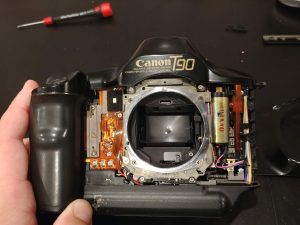
I found several “hacks” online for repairing the T90 in which you could use a strong magnet and place it next to some solenoid inside of the camera to demagnetize some part of the camera that would magically fix it. This required removal of a small piece of plastic trim around the front of the camera. It was easy enough to do, so I figured what do I have to lose?
I’ll just skip to the part where I tell you the “magnet hack” didn’t work. I used everything from simple refrigerator magnets to rare earth neodymium magnets from disassembled hard drives and I still kept getting the HELP message.
Then I found one more suggestion, which was to simply bang the camera on a hard surface until it started working. I thought “what the hell” and gave it shot! To my surprise, after a few very firm whacks on my basement floor, the camera started working! I could fire the shutter at every speed!
I fixed it! I was super pumped that I could finally shoot this wonderful T90, but it was close to midnight when I got it working, so I set it on the table to take it out the next day…
…and it was broke again. It would seem the ‘banging it on the floor’ method only works temporarily. I repeated my “repair” about half a dozen more times, repeatedly hitting it harder and harder, each time getting the shutter to work for maybe 5-10 minutes, but any longer than that and it returned to it’s previous EEE state.
I shelved this first Canon T90 and ended up finding another shortly after, but that one too, was broke. Oddly, it neither displayed the EEE or HELP messages, but rather just would never fire the shutter no matter what I did to it. With a sense of defeat, I threw the two T90s into a box and placed them in my “Camera Graveyard of Doom”, aka, my basement for it’s inclusion here in the 6th incantation of Cameras of the Dead.
If this had been a working camera, I’d have a complete historical look at the camera, its success, how it’s used and some sample pics I got from it, but that’ll never happen, and frankly, with the reputation the camera has, even if I had an opportunity to pick up another, I likely wouldn’t so here is a quick gallery of what the camera looks like and how it might have worked.

I’ll start with the viewfinder as it’s one of my favorite parts of the camera. Using a red 7-segment LED display straight out of Canon’s earlier A-1, the display within the viewfinder reminds me of one of those hand held Mattel football games that I had as a kid. Although it looks cool, it likely seemed dated compared to back lit LCD displays that were becoming more and more common with SLRs by the mid 1980s.
Curiously, along the right side of the display is a back lit LCD display that is used as the exposure metering display. Although the T90 offers full program auto exposure, you can manually set aperture, shutter speed, or both while still taking a light reading using this display. The display itself works fine, but it is a completely different color and looks strangely out of place compared to the bright red LED display along the bottom.
The top plate is uncluttered with two mode buttons that work in conjunction with a selector wheel on the camera’s right side between the LCD and shutter release. This being a camera aimed at the professional photographer, there is no integrated flash, rather you have a hot shoe with the necessary connections that when connected to a Canon Speedlite 300TL, offers all the latest TTL flash metering modes. When powered on, the LCD shows all pertinent information you would expect to see from a pro SLR’s top screen. The back of the camera has even more buttons, both above and below the film back. The back is removable so that you can attach a couple different data backs that were available. The film compartment is very modern and shows connections for DX detection, and is fully automatic. When loading in a new film cassette, extend the leader out to the orange mark, close the door, and the camera does the rest.
If you didn’t know better, judging by the T90s very 1986-esque design with lots of plastic and rounded corners, you would be forgiven for assuming this was an auto focus camera that uses Canon’s later EOS mount, but no, it was Canon’s venerable FD mount’s last hurrah, a fully manual focus camera that accepted every single FL/FD mount lens that came before it. When I acquired this T90, it came body only, so I mounted this 50mm f/1.4 S.S.C. lens which was a type that likely would have been used on it.
The side of the camera reveals a door which when held open, reveals several of the camera’s lesser used buttons, such as those for manually rewinding the film, battery check, self timer, and a viewfinder illumination switch. Keeping these lesser used buttons out of the way behind a door was a smart choice in keeping the top plate as uncluttered as possible.
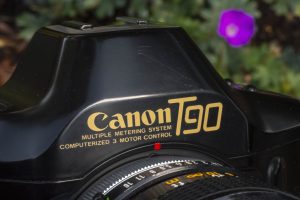
I think it’s rather curious that Canon named this camera the T90, including it in their T-series of cameras with the T50 and T70 (I am excluding the T60 as it wasn’t available upon the T90’s release and it wasn’t even made by Canon), this camera looks nothing like those other models, and is significantly more advanced. I have to imagine a customer walking into a camera store in 1986 likely would have been confused upon seeing all three T-series models side by side by side as the T90 was clearly in a different league, both feature wise and price wise from the other two.
It’s obvious to me that at one time the T90 was a fantastic camera, and in good working condition, would still be today. It’s a very solidly built camera with excellent ergonomics, a great shutter and metering system, uses every FD/FL mount lens available, and has nearly every feature you could possibly want in an SLR camera.
Sadly, the Canon T90 has the unfortunate distinction of being released at a time when a lot of new and innovative technology was being put into cameras for the first time, but that same technology was never intended to stay working 3+ decades later. Is it reasonable to expect any electronic camera to work for such a long time? Probably not, but when you can regularly pick up a 60 year old Nikon F or an 80 year old Leica and it still works fine, but something built within my lifetime is no longer usable, it’s a little disappointing.
My Conclusions
The first time I did one of these Cameras of the Dead articles, my intent was to cover 3 cameras that I thought were worth sharing, but no longer worked. I had a “rule” back then that I would only keep cameras that worked, and while I still try to adhere to that, as I accumulate more models, the number of dead ones increases. While I do enjoy writing these shorter articles for dead cameras, I’d much rather do a full write up of a working one.
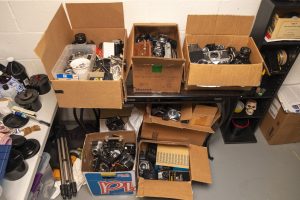
Now, whenever I start planning the next …Dead article, I have a pretty big selection of models to choose from. The last two have had 3 different cameras from 3 different decades, which is a theme I’d like to continue with future articles. As I write this, I have well over a dozen more cameras that I could include in the next one. The image to the right is a partial image of my broken or marginally working cameras in my basement. Some I keep for spare parts, others are worth so little, it’s not even worth my time to sell them, and others really should be thrown in the trash, but well, I don’t.
What cameras will I include in the 7th edition that will predictably be posted this Halloween? What cheesy horror movie will I reference as having some vague similarity to my post? Stay tuned, mwaaaa haaa haaaa haaaaaaa!!!!!



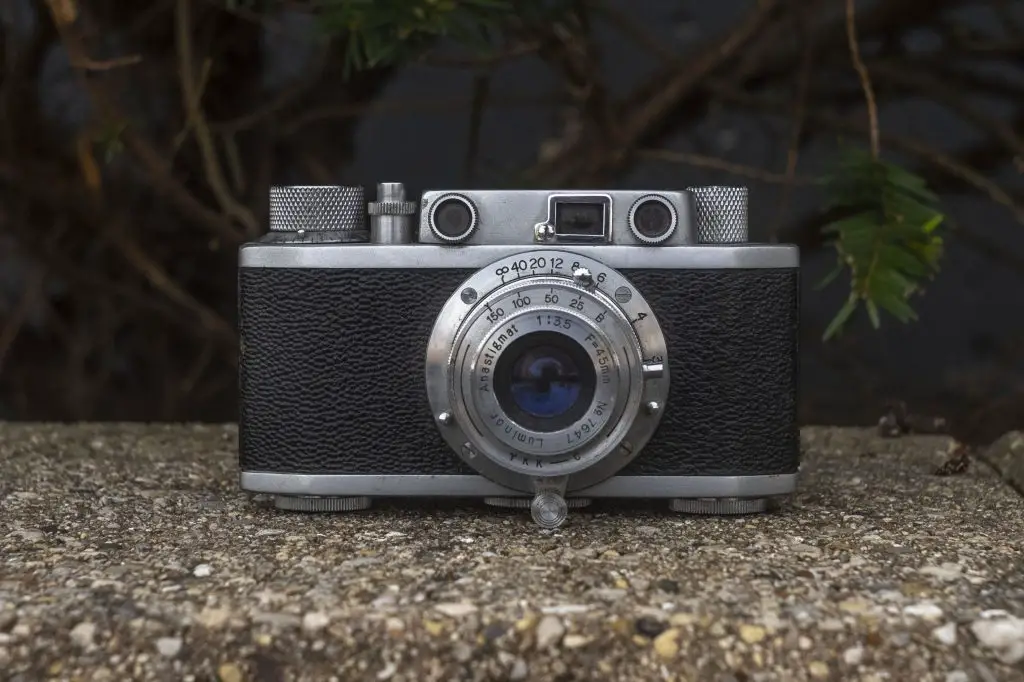


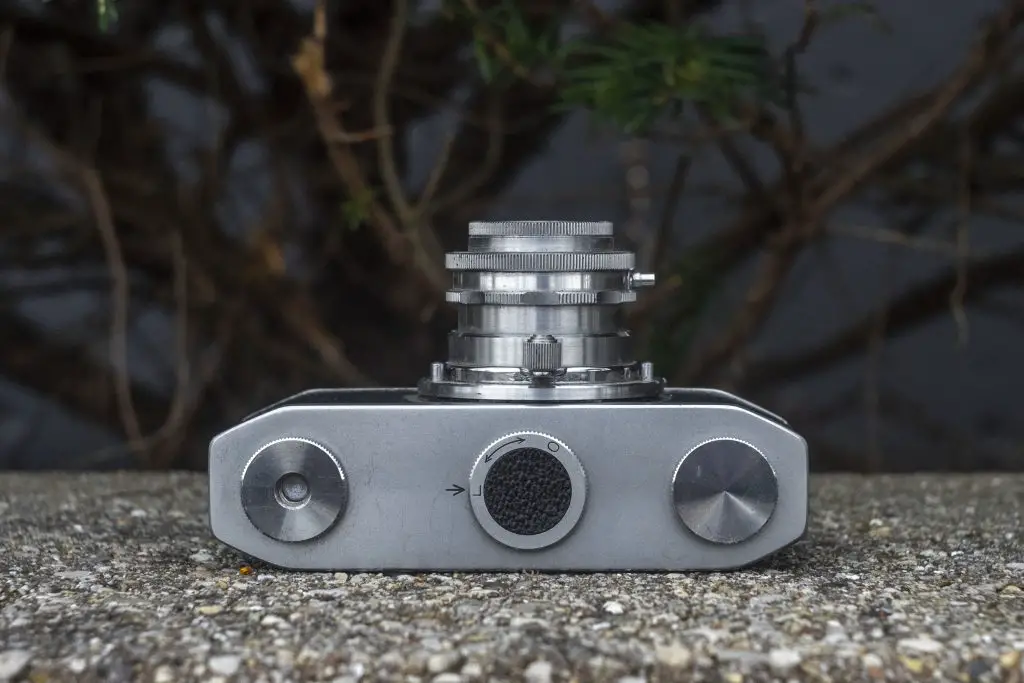
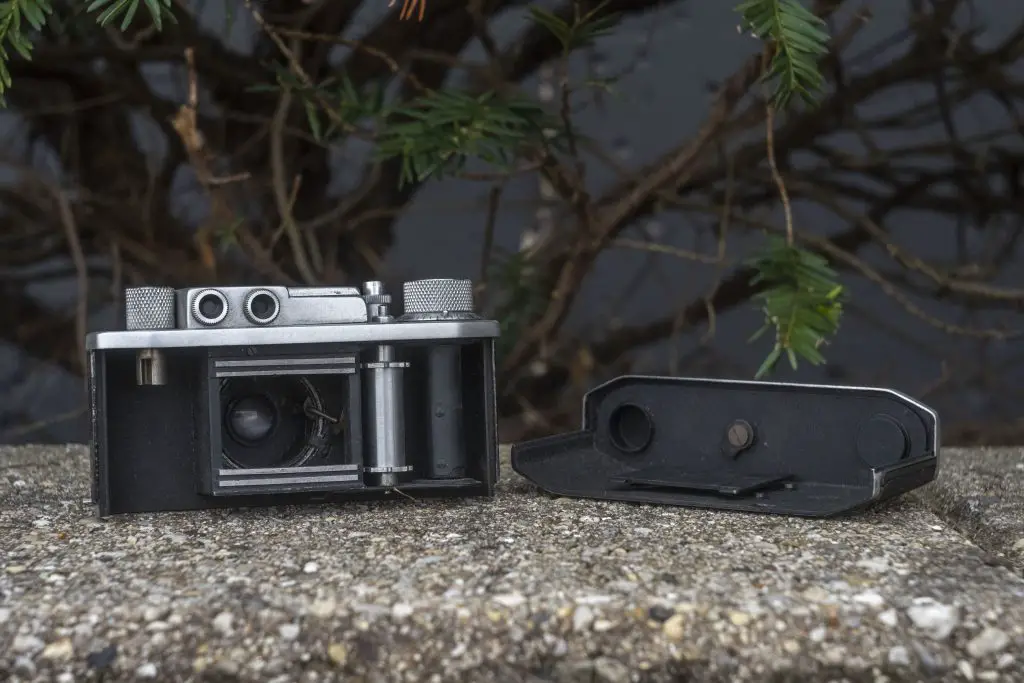
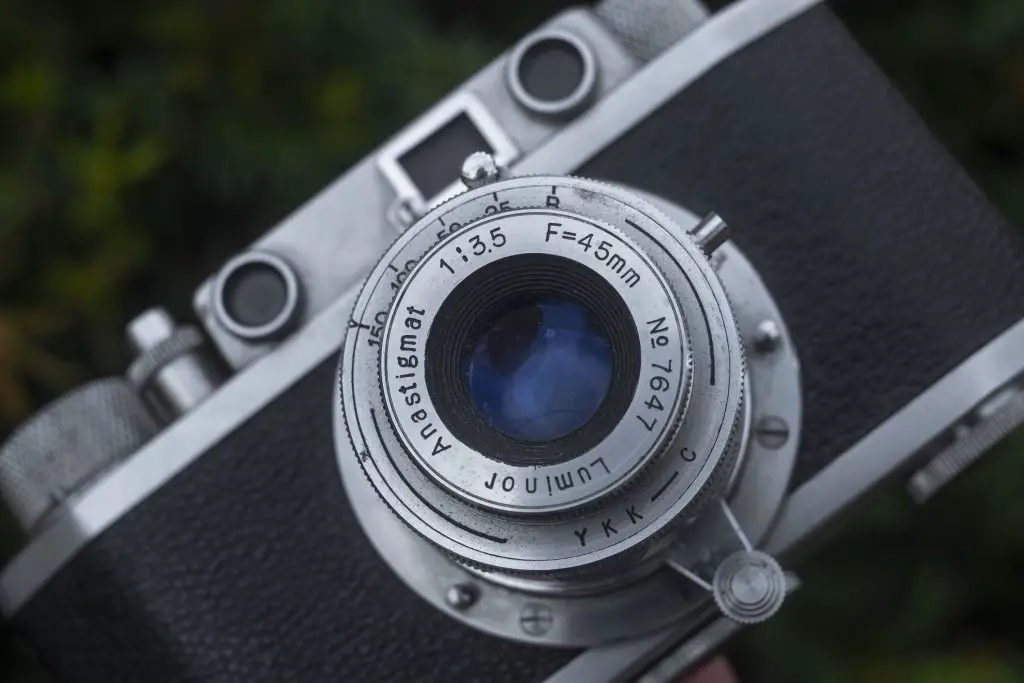
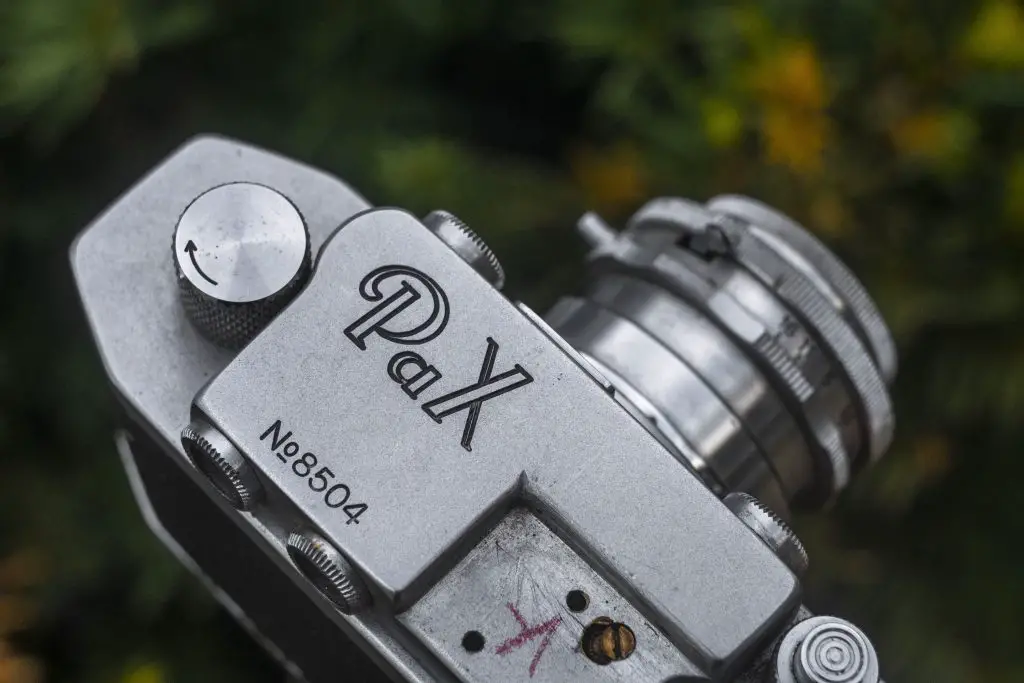

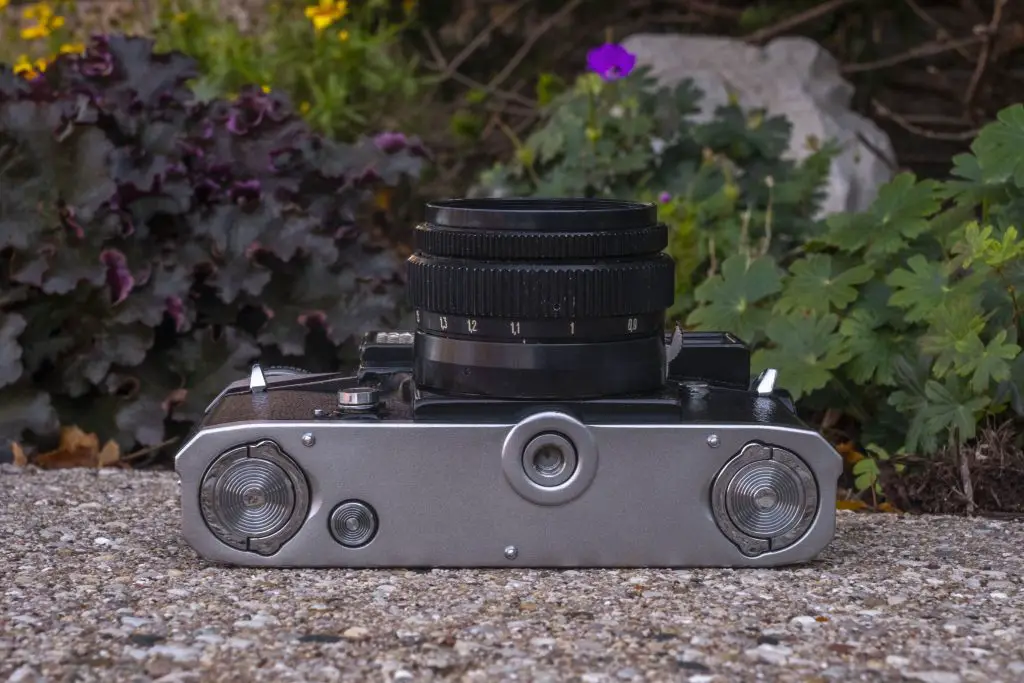
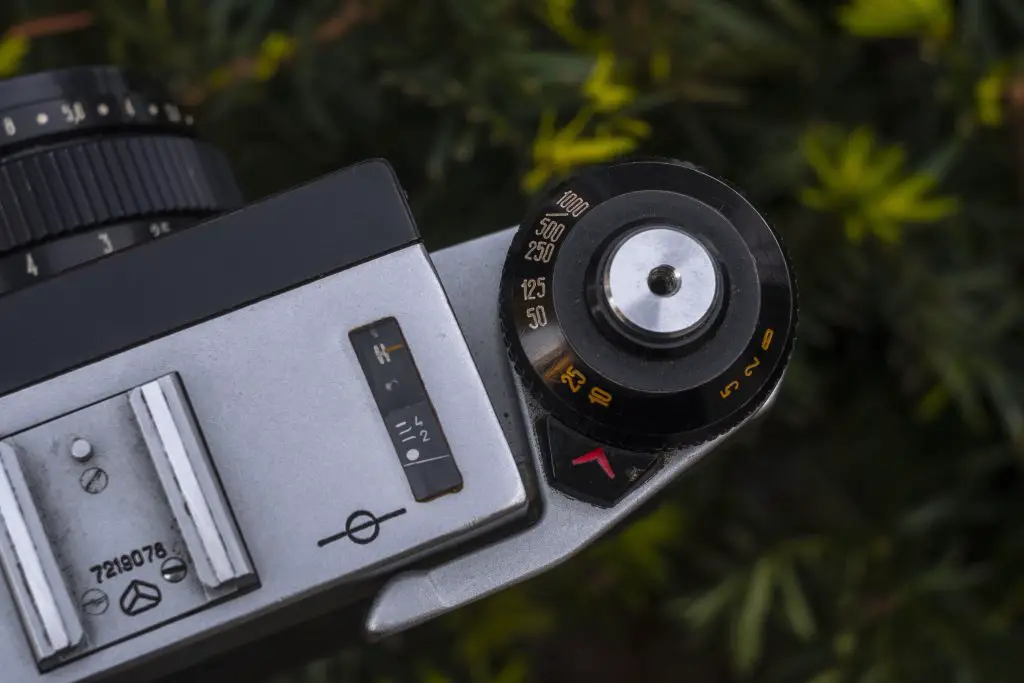
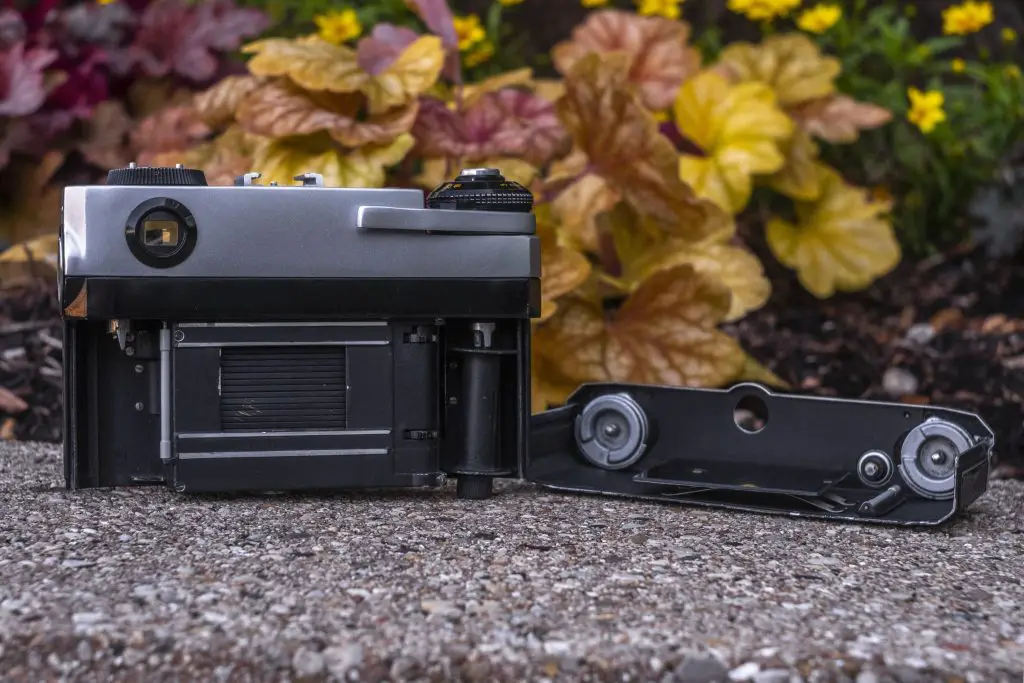
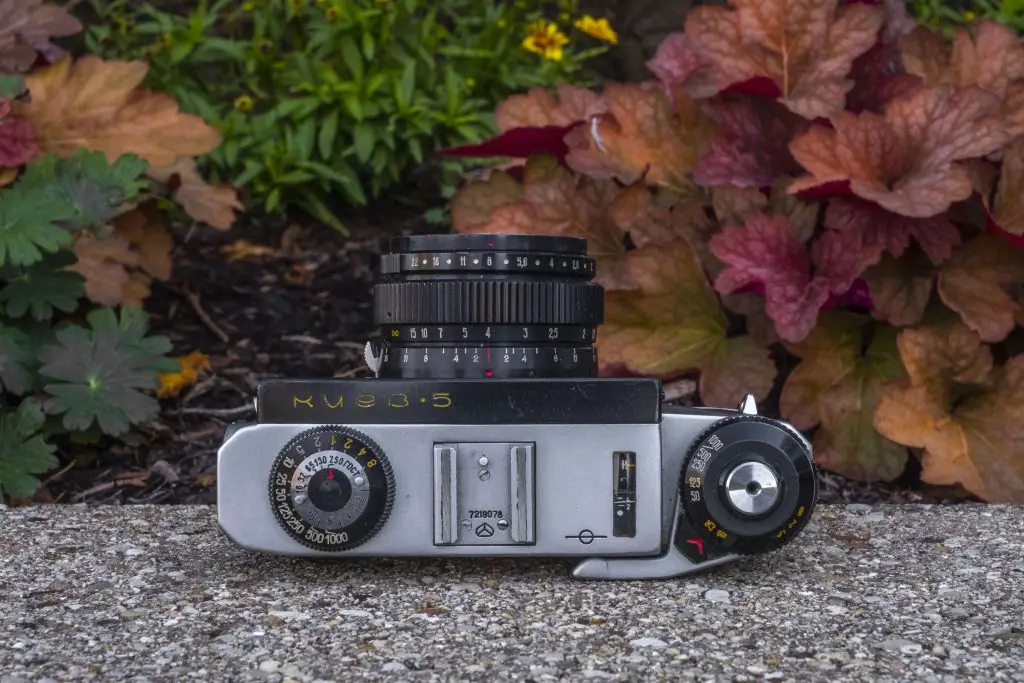
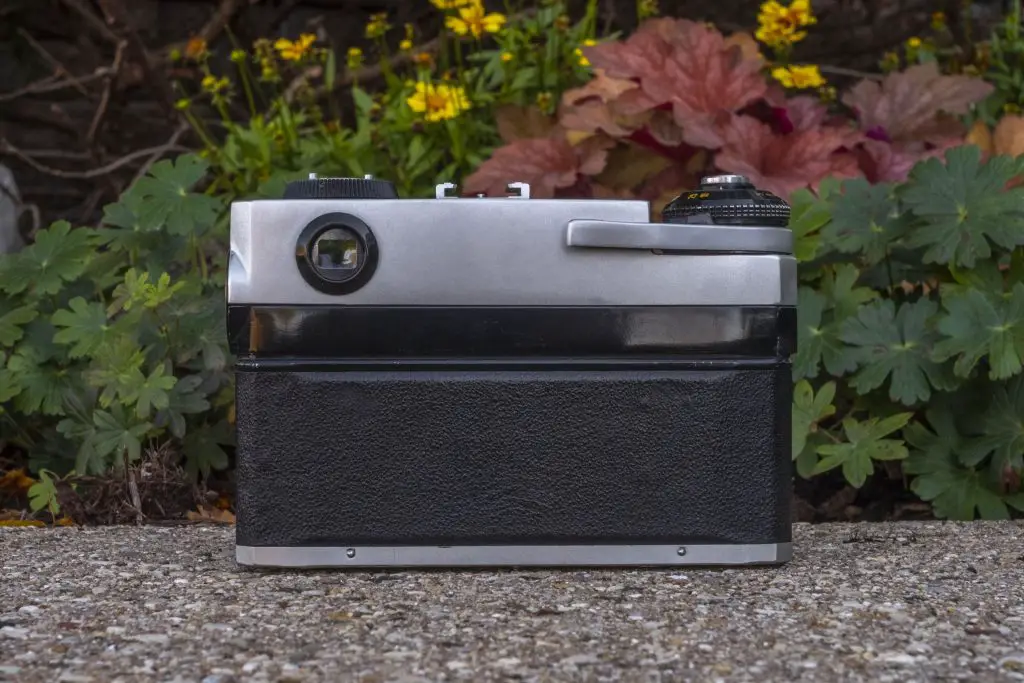
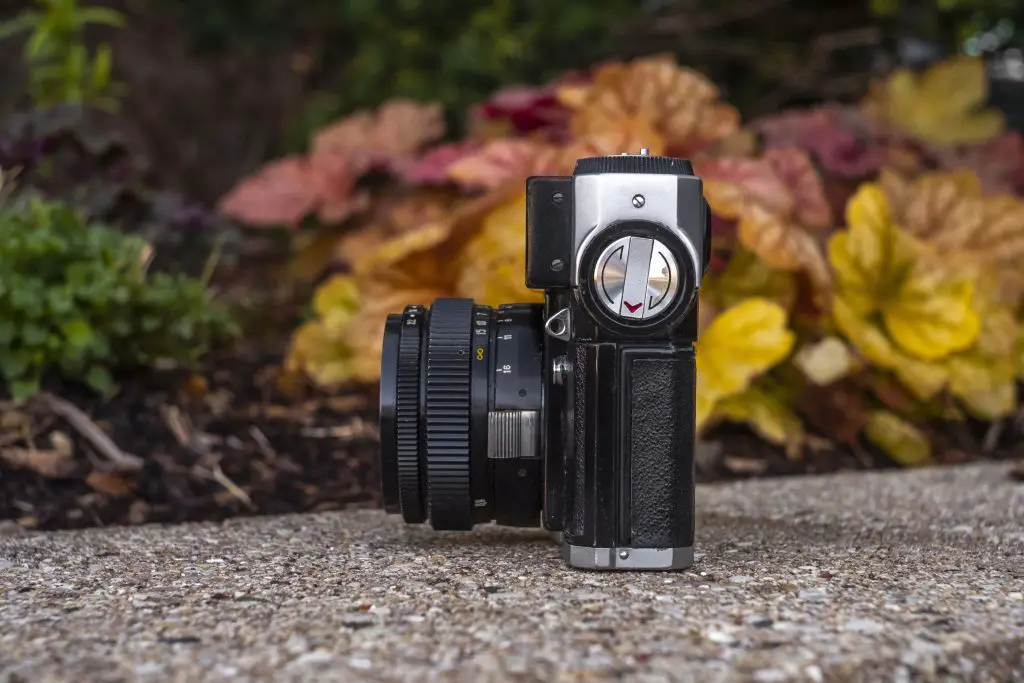
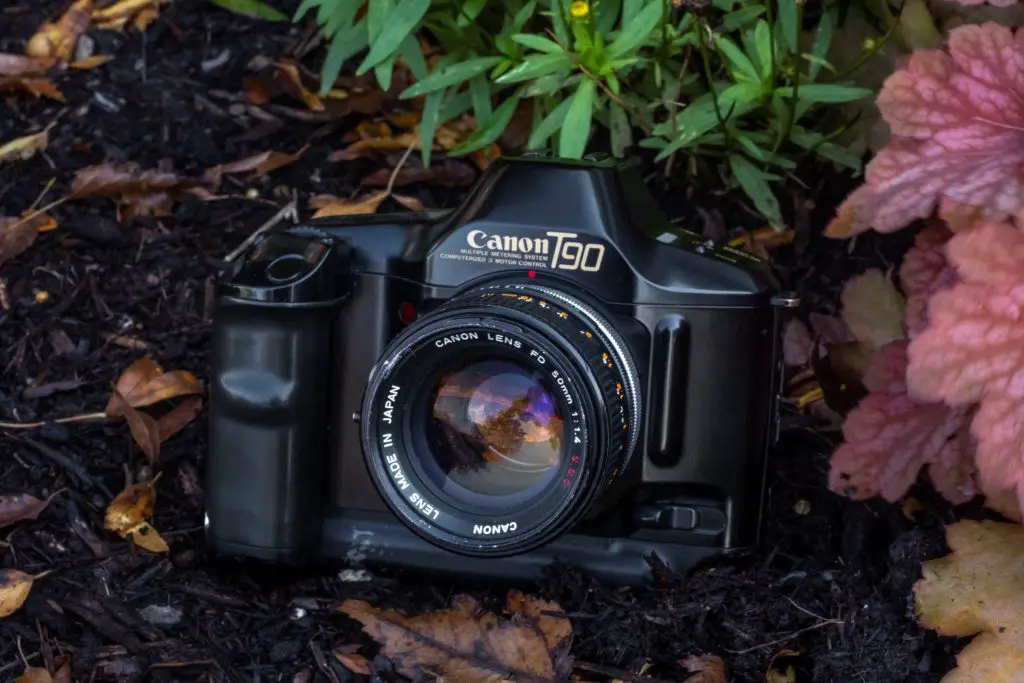


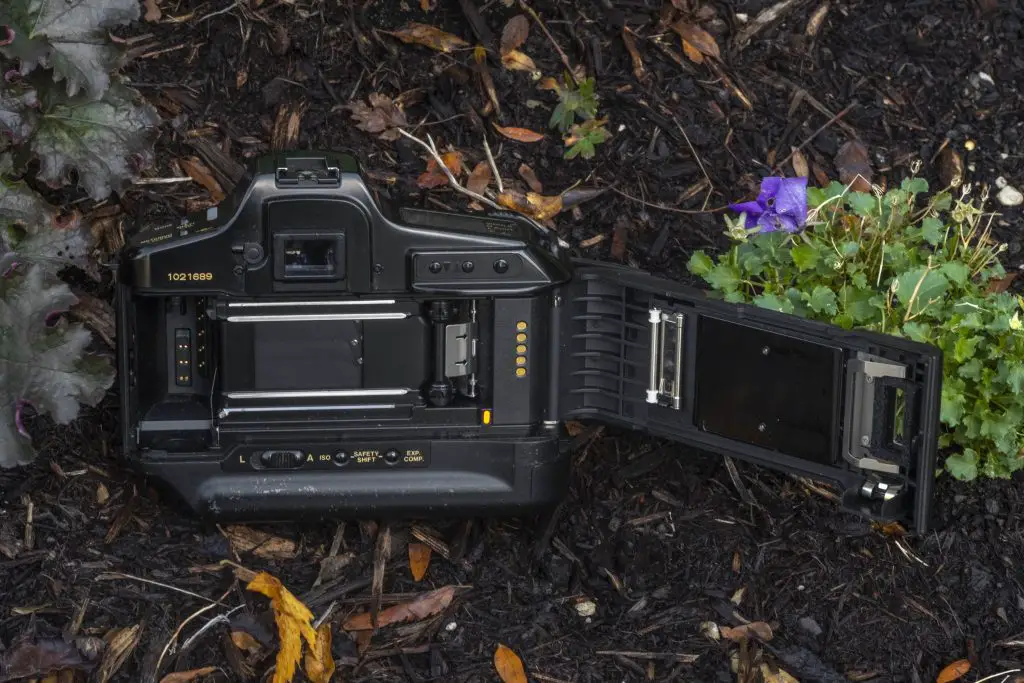
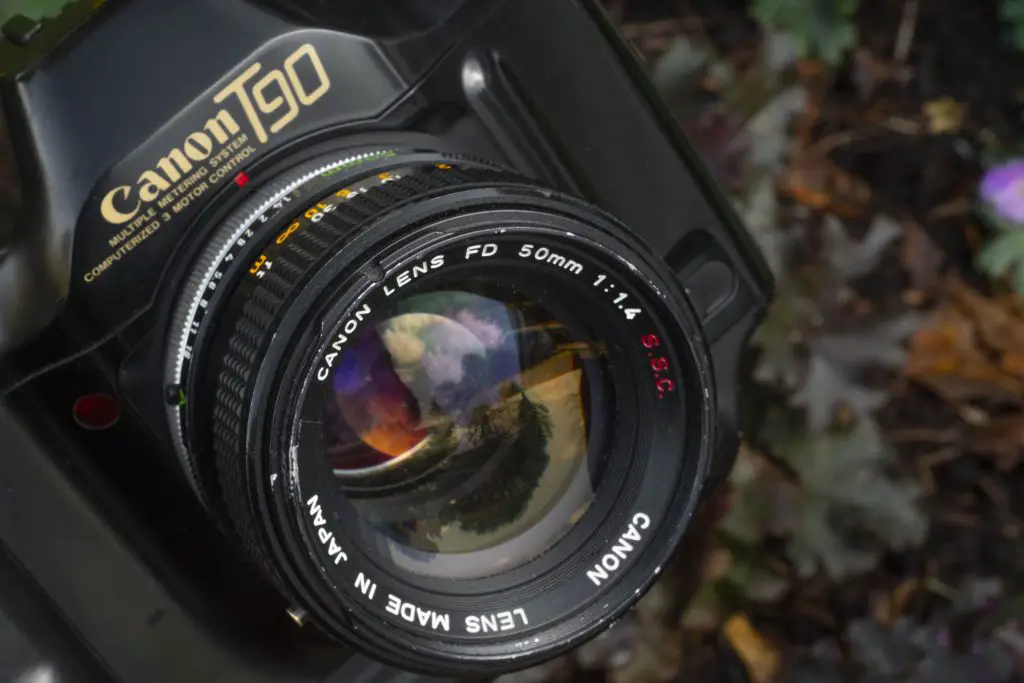
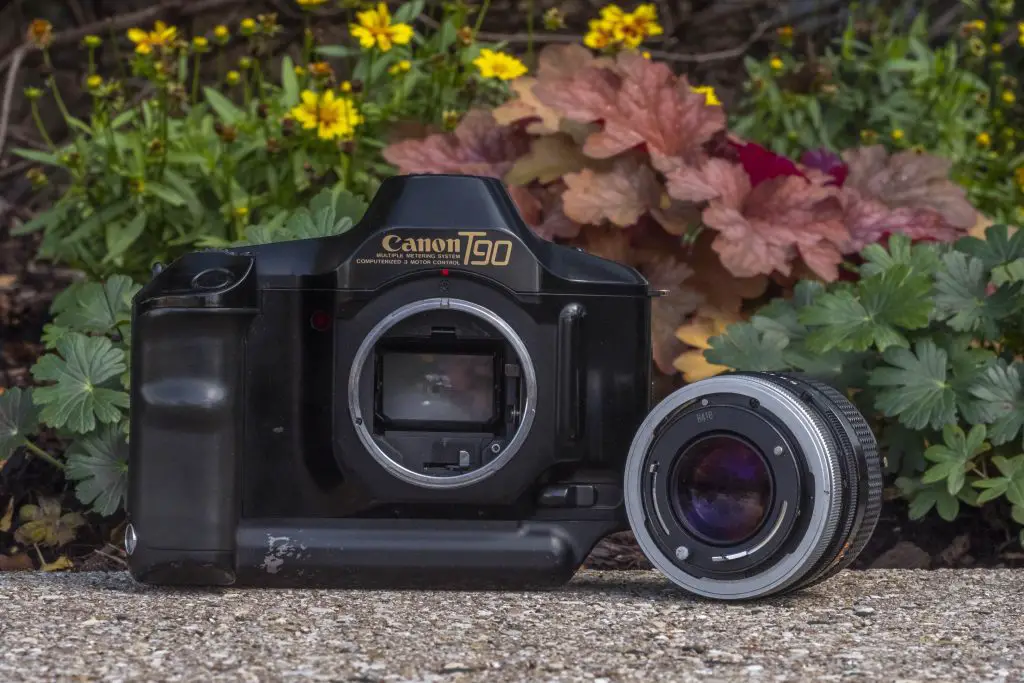
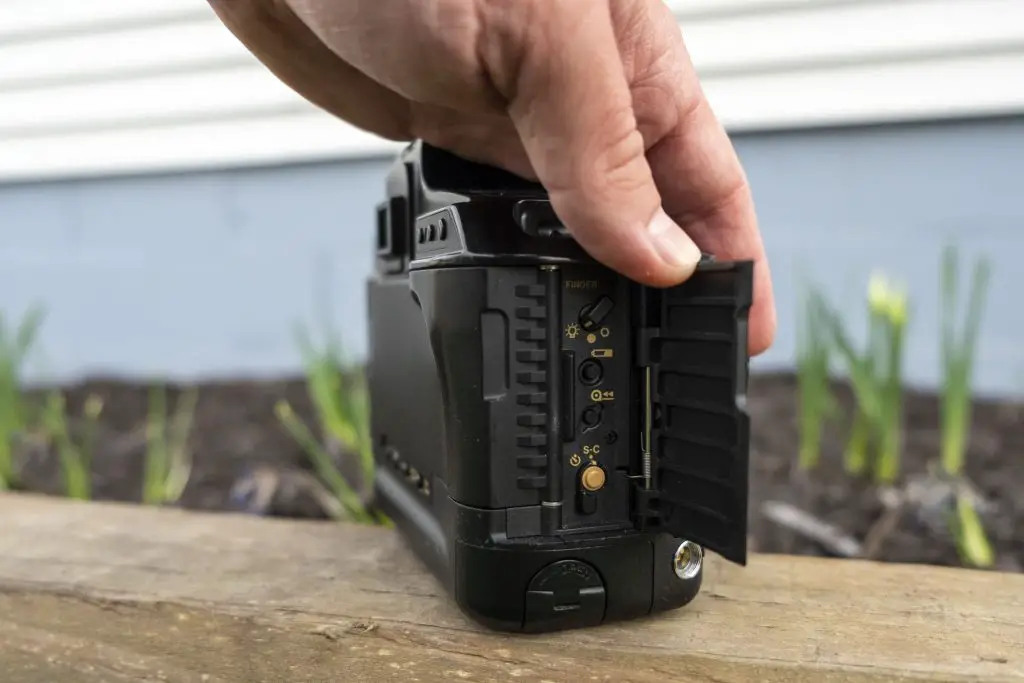
Oh, but the PaX is just ADORABLE! If it had looked like an ordinary leaf shutter rangefinder, you’d never have heard of it 60 years on. And look at the amount of space that they fit that leaf shutter into, it’s practically invisible on the lens barrel! That is an achievement, and in the M2 they had stretched the speed range out to 1/10-1/300. I’ve kept my M2, and I might be tempted to get a PaX 35 for it as a playmate.
I can’t help noting that your most unpleasant feature of the Kiev is an exact copy same feature of the Zeiss Contax II – you’re right, though, they are rough on eyeglass lenses.
As for the T90, I expect that what you really need to do is get some solvent inside that solenoid to clean off the sticky residue that’s making it hang up until you bang it on a table to free it. Whether you can do that without destroying something I’m not sure, but it seems it should have been something that they foresaw a need for their techs to be able to reach.
:)=
Your “graveyard cartons” look all too familiar. Seems like there’s a similar collection in the far corner of my office! Have you noticed that the Yamato Pax commands a price premium on eBay, simply thanks to its name. Another such camera is the “Drug” from KMZ made during the Soviet era.
Great read, thank you for the info on the PAX camera. I was stationed in Japan during the early 70’s and took up an interest in Japanese cameras, both pre and post war. I never saw a photo, of this clarity, of a PAX camera and related literature before. Most examples I have found are inop-display cameras and basket cases. It is nice that you found one that works.
Note: I am very partial to Leotax and the Topcon family of cameras R/F: 35L, S and SLR’s: B, C, R, RE and DM’s. They are wonderful cameras but seem to be forgotten by most. the David C
Very entertaining article Mike. My Camera Graveyard of Doom is my lounge and bedroom, if only I were more technically proficient, and less eager to disembowel every camera that comes into my possession…….
Mike, not content with producing a Barnack look-alike, as you probably know, their later M4 is based on Leica’s M3. The satin chrome finish on my is pitted, but everything works, of a sorts The good points are the helicoid focus is smooth as is the film wind. The rangefinder is accurate, but sadly the spot is quite dull. The bad thing is all the shutter speeds fire, but are erratic.
I used a T90 hard for years, and it displaced my previous New F1. It was lighter, had a built-in motor drive, and was easier to control. Now I’ve got two T90 bodies that don’t work, but I’d pay good money to have them fixed. Anyone have any idea who could fix them? My regular repair guy doesn’t want to know…
Sadly, I can’t help you find a T90 repair person. I have heard mention of some people who have taken on the role in the past, but they’re drying up quickly. There is already a shortage of people willing and able to properly repair mechanical cameras, and finding people who will touch the complex electronic one is even harder. Sadly, I think that the time as come for models like the T90 where most of them are largely display pieces.
Great read on the T90 Mike, mine are also suffering from the dreaded EEE message. I got my first T90 a few months after it was released and it quickly replaced my F1’s as my go to camera and remained so for many years until superseded by a 20D when I decided to go digital for most everyday photography. I absolutely loved the T90 and would use another in a heartbeat if I could find a working example but all four I have are dead so that is not likely to happen. The 20D is long dead as well replaced by a 60D & a 7D. Of course my F1’s are still working perfectly. Regards Richard from downunder.
Just sent two dead T90s to the Camera Clinic in Mandan, ND, and for $120 each they tell me they will be fixed. Will let you know.